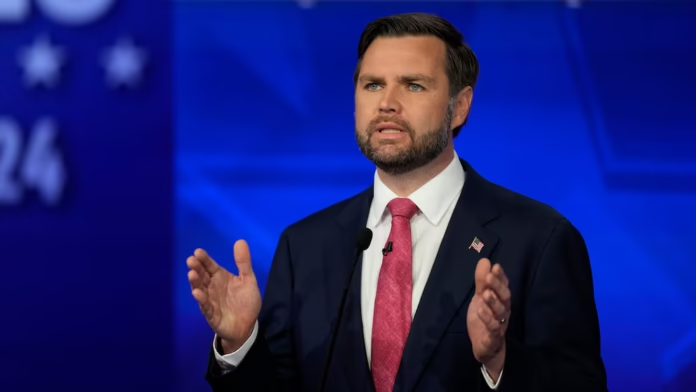The tense George Stephanopoulos JD Vance exchange on national television has become one of the most talked-about moments in U.S. political media this week. During a high-profile Sunday interview, ABC anchor George Stephanopoulos and Vice President JD Vance engaged in a sharp back-and-forth over allegations involving a senior administration official. Their confrontation, marked by repeated interruptions and pointed questioning, quickly made headlines and has continued to reverberate across political and media circles.
A Clash That Captured National Attention
The interview took place on Sunday, October 12, 2025, during Stephanopoulos’s flagship political program. From the opening moments, it was clear the conversation would not follow a typical, scripted format. Stephanopoulos pressed Vice President Vance repeatedly on whether a key administration figure accepted a large cash payment during a sting operation. Vance rejected the premise and criticized the media’s role in amplifying what he described as “manufactured scandals.”
The exchange quickly escalated as Stephanopoulos pressed for direct answers. Vance, maintaining a defiant posture, accused the host of ignoring pressing issues like government spending and border security. Stephanopoulos, in turn, stated that the questions were based on documented evidence and deserved a clear response from the administration’s second-in-command.
Key Moments From the Confrontation
Several moments stood out during the interview, turning it from a standard political discussion into a defining media clash:
- Direct Questioning on Allegations: Stephanopoulos repeatedly asked whether a senior official accepted $50,000 in cash during an undercover investigation.
- Vance’s Deflection: The Vice President did not directly answer, instead accusing the media of bias and shifting attention toward what he considered more important national priorities.
- On-Air Tension: As Vance continued to avoid a direct answer, Stephanopoulos interjected, leading to overlapping dialogue that drew strong reactions from viewers.
- Abrupt Commercial Break: In a rare move, Stephanopoulos cut to commercial mid-answer, declaring that the question remained unanswered.
This combination of aggressive questioning, political defensiveness, and sudden interruption gave the segment an intensity rarely seen on Sunday talk shows.
Why This Matters Politically
The exchange between George Stephanopoulos and JD Vance goes beyond television theatrics. It highlights deeper tensions between political leaders and major media institutions in an increasingly polarized environment. For the Vice President, the interview represented a high-stakes moment to defend his administration amid allegations of misconduct involving a key figure. For Stephanopoulos, it was a chance to demonstrate journalistic rigor and press for accountability at the highest level of government.
The political implications are significant:
- Public Perception: Millions of viewers witnessed the Vice President decline to give a direct yes-or-no answer to a serious allegation.
- Media-Government Relations: The confrontation reinforced perceptions of strained relations between the current administration and mainstream media networks.
- Partisan Reactions: Supporters of Vance praised his pushback against what they view as hostile questioning, while critics argued his evasiveness raised more questions than it answered.
Media Strategy vs. Journalistic Persistence
One of the most striking elements of the George Stephanopoulos JD Vance interview was the contrast in communication strategies. Vance appeared determined to reframe the conversation toward policy issues and dismiss the allegations as politically motivated. Stephanopoulos, however, stayed focused on one specific question, refusing to pivot despite the Vice President’s attempts to redirect.
This created a rare moment of live television in which neither participant yielded. Stephanopoulos’s decision to cut to a commercial mid-answer underscored his determination to avoid allowing political talking points to dominate the segment. Vance’s refusal to give a definitive answer highlighted his administration’s cautious media approach during ongoing investigations.
Timeline of Key Events
| Date | Event |
|---|---|
| September 2024 | Alleged undercover incident involving the senior official takes place. |
| Early October 2025 | Reports resurface, prompting renewed media attention. |
| October 12, 2025 | Stephanopoulos interviews JD Vance on national television. |
| Immediately After | Political and media figures react, sparking nationwide debate. |
This timeline shows how a past event, combined with new scrutiny, created the backdrop for one of the most intense interviews of the year.
Reactions Across the Political Spectrum
The aftermath of the interview saw swift and polarized reactions:
- Supporters of JD Vance praised him for standing firm against what they described as media hostility, arguing that he correctly prioritized national policy over scandal-driven narratives.
- Critics of the administration argued that his refusal to provide a direct answer signaled potential problems and undermined public trust.
- Media analysts debated Stephanopoulos’s handling of the segment, with some calling it a masterclass in accountability journalism, while others suggested that the abrupt cut to commercial might deepen partisan divides.
The incident has since become a focal point in discussions about how journalists should navigate interviews with top political figures who challenge the framing of questions.
Potential Fallout and What’s Next
The confrontation could have several ripple effects in the coming weeks:
- Renewed Investigations: The public spotlight may push officials to release additional information regarding the allegations.
- Increased Media Scrutiny: Both the administration and Stephanopoulos’s program are likely to face further questions in upcoming press events.
- Political Strategy Adjustments: The Vice President’s communications team may refine its media strategy to avoid similar on-air showdowns.
- Impact on Public Trust: How this situation evolves may influence public confidence in both government transparency and media credibility.
The exchange underscored how live interviews can shape political narratives in real time, sometimes more powerfully than official press releases or policy speeches.
A Moment That Will Be Remembered
The George Stephanopoulos JD Vance interview was more than a clash of personalities. It was a defining moment in the relationship between political power and media accountability in 2025. As the story continues to develop, both figures remain under intense scrutiny—one as a key media voice, the other as a sitting Vice President navigating controversy within his administration.
This confrontation has set the stage for further developments, and all eyes will be on what happens next.
